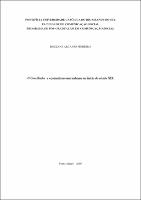| Compartilhe o registro |


|
Use este identificador para citar ou linkar para este item:
https://tede2.pucrs.br/tede2/handle/tede/6968Registro completo de metadados
| Campo DC | Valor | Idioma |
|---|---|---|
| dc.creator | Pinheiro, Roseane Arcanjo | - |
| dc.creator.Lattes | http://buscatextual.cnpq.br/buscatextual/visualizacv.do?id=K4737825Z7 | por |
| dc.contributor.advisor1 | Hohlfeldt, Antônio Carlos | - |
| dc.contributor.advisor1Lattes | http://buscatextual.cnpq.br/buscatextual/visualizacv.do?id=K4783262Z9 | por |
| dc.date.accessioned | 2016-09-27T12:15:56Z | - |
| dc.date.issued | 2016-06-30 | - |
| dc.identifier.uri | http://tede2.pucrs.br/tede2/handle/tede/6968 | - |
| dc.description.resumo | Esta pesquisa objetiva analisar as práticas comunicacionais desenvolvidas pelo jornal O Conciliador do Maranhão, em São Luís, entre abril de 1821 e julho de 1823. Trata-se do primeiro jornal impresso da província, lançado pela administração local, ligada ao governo português em um período de ruptura política entre a agora ex-colônia e Portugal, movimento que, em um primeiro momento, não foi seguido pelo Maranhão. Entendemos, a partir da teoria construcionista, que a notícia, enquanto unidade discursiva, institui uma referência sobre a realidade, articulando as forças sociais, culturais, políticas, tecnológicas e históricas. Para apreendermos as diferentes relações que se estabeleceram então, adotamos o conceito de campos de poder, explanado por Pierre Bourdieu e delimitamos como categorias de análise os campos político, econômico e cultural. Buscamos as colaborações teóricas da história cultural sobre a produção, as formas de circulação e a apropriação das informações. Problematizamos o discurso jornalístico com a finalidade de compreendermos as representações elaboradas pelo impresso maranhense. O jornal citado, além de divulgar o discurso político em apoio à monarquia absolutista, também propiciou referências sobre o cotidiano da cidade, o que nos mostra que o jornal citado se constituiu em um espaço complexo, porque trouxe elementos sobre as disputas que movimentaram segmentos da população e sedimentou um projeto de nação naquele momento histórico. A existência de O Conciliador também acenou com a existência do campo jornalístico no começo no século XIX, engendrando pela atuação de camadas sociais capazes de aprender as informações, referendar significados sobre a organização social e transformar ou manter a ordem estabelecida. | por |
| dc.description.abstract | This research aims to analyze the communication practices developed by the newspaper O Conciliador do Maranhão in São Luís from April 1821 to July 1823. It was the first printed newspaper of the province, launched by the local administration that was associated to the Portuguese government in a period of political disruption between the former colony and Portugal, a movement that, at first, was not followed by Maranhão. Based on the constructionist theory, we understand that news, as discursive unity, institute a reference for reality, articulating social, cultural, political, technological and historical forces. To apprehend the different relations that were established in that moment, we adopted the concept of power fields, explained by Pierre Bourdieu, and we delimited the political, economic and cultural fields as categories of analysis. We sought theoretical contributions of the cultural history on production, ways of circulation and appropriation of information. We problematized the journalistic discourse in order to understand the representations elaborated by the newspaper from Maranhão. This newspaper, besides disclosing a political discourse supporting the absolute monarchy, also provided references about the city’s everyday life, which show us that the newspaper was a complex space, because it brought elements of the disputes that agitated segments of the population and it established a national project at that historic moment. The existence of O Conciliador also pointed out the existence of the journalistic field in early nineteenth century, engendered by the work of social strata which were able to learn the information, attest meanings for social organization and change or maintain the established order. | eng |
| dc.description.provenance | Submitted by Setor de Tratamento da Informação - BC/PUCRS ([email protected]) on 2016-09-27T12:15:56Z No. of bitstreams: 1 TES_ROSEANE_ARCANJO_PINHEIRO_COMPLETO.pdf: 5785336 bytes, checksum: f842a93c60e9c10f0268f9d9ce6aa0bb (MD5) | eng |
| dc.description.provenance | Made available in DSpace on 2016-09-27T12:15:56Z (GMT). No. of bitstreams: 1 TES_ROSEANE_ARCANJO_PINHEIRO_COMPLETO.pdf: 5785336 bytes, checksum: f842a93c60e9c10f0268f9d9ce6aa0bb (MD5) Previous issue date: 2016-06-30 | eng |
| dc.description.sponsorship | Coordenação de Aperfeiçoamento de Pessoal de Nível Superior - CAPES | por |
| dc.format | application/pdf | * |
| dc.thumbnail.url | http://tede2.pucrs.br:80/tede2/retrieve/166303/TES_ROSEANE_ARCANJO_PINHEIRO_COMPLETO.pdf.jpg | * |
| dc.language | por | por |
| dc.publisher | Pontifícia Universidade Católica do Rio Grande do Sul | por |
| dc.publisher.department | Faculdade de Comunicação Social | por |
| dc.publisher.country | Brasil | por |
| dc.publisher.initials | PUCRS | por |
| dc.publisher.program | Programa de Pós-Graduação em Comunicação Social | por |
| dc.rights | Acesso Aberto | por |
| dc.subject | JORNALISMO POLÍTICO - BRASIL | por |
| dc.subject | JORNALISMO - HISTÓRIA | por |
| dc.subject | COMUNICAÇÃO SOCIAL | por |
| dc.subject.cnpq | CIENCIAS SOCIAIS APLICADAS::COMUNICACAO | por |
| dc.title | O Conciliador e o jornalismo maranhense no início no século XIX | por |
| dc.type | Tese | por |
| Aparece nas coleções: | Programa de Pós-Graduação em Comunicação Social | |
Arquivos associados a este item:
| Arquivo | Descrição | Tamanho | Formato | |
|---|---|---|---|---|
| TES_ROSEANE_ARCANJO_PINHEIRO_COMPLETO.pdf | Texto Completo | 5,65 MB | Adobe PDF |  Baixar/Abrir Pré-Visualizar |
Os itens no repositório estão protegidos por copyright, com todos os direitos reservados, salvo quando é indicado o contrário.




